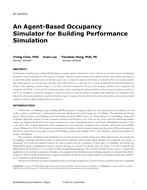Description
Traditionally, in building energy modeling (BEM) programs, occupancy inputs are deterministic and less indicative of real world scenarios, contributing to discrepancies between simulated and actual energy use in buildings. This paper presents an agent-based occupancy simulator, which models each occupant as an agent with specified movement events and statistics of space uses. To reduce the amount of data inputs, the simulator allows users to group occupants with similar behaviors as an occupant type, and spaces with similar function as a space type. It is a web-based application with friendly graphical user interface, cloud computing, and data storage. A case study is presented to demonstrate the usage of the occupancy simulator and its integration with EnergyPlus and obFMU. It first shows the required data inputs and the results from the occupancy simulator. Then, the generated occupant schedules are used in the EnergyPlus and obFMU simulation to evaluate the impacts of occupant behavior on building energy performance. The simulation results indicate that the occupancy simulator can capture the diversity of space’s occupancy behavior rather than the static weekly profiles, and can generate realistic occupancy schedules to support building performance simulation.
Citation: 2016 Annual Conference, St. Louis, MO, Conference Papers
Product Details
- Published:
- 2016
- Number of Pages:
- 8
- Units of Measure:
- Dual
- File Size:
- 1 file , 1.1 MB
- Product Code(s):
- D-ST-16-C037




